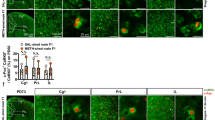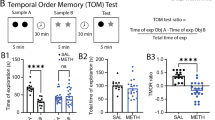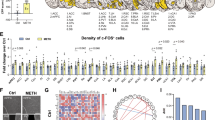Abstract
The use of psychostimulants is often associated with hypersexuality, and psychostimulant users have identified the effects of drug on sexual behavior as a reason for further use. It was previously demonstrated in male rats that methamphetamine (Meth), when administered concurrently with sexual behavior results in impairment of inhibition of sexual behavior in a conditioned sex aversion (CSA) paradigm where mating is paired with illness. This is indicative of maladaptive sex behavior following Meth and sex experience. The present study examined the neural pathways activated during inhibition of sexual behavior in male rats and the effects of concurrent Meth and sexual behavior on neural activity, using ERK phosphorylation (pERK). First, exposure to conditioned aversive stimuli in males trained to inhibit sexual behavior in the CSA paradigm increased pERK expression in medial prefrontal (mPFC), orbitofrontal cortex (OFC) and areas in striatum and amygdala. Second, effects of concurrent Meth and sex experience were tested in males that were exposed to four daily sessions of concurrent Meth (1 mg/kg) or saline and mating and subsequently exposed to CSA one week after last treatment. Meth and mating-treated males showed significant impairment of inhibition of mating, higher pERK expression under baseline conditions, and disrupted pERK induction by exposure to the conditioned aversive stimuli in mPFC and OFC. These alterations of pERK occurred in CaMKII-expressing neurons, suggesting changes in efferent projections of these areas. Altogether, these data show that concurrent Meth and mating experience causes maladapative sexual behavior that is associated with alterations in neural activation in mPFC and OFC.
Similar content being viewed by others
Log in or create a free account to read this content
Gain free access to this article, as well as selected content from this journal and more on nature.com
or
References
Agmo A (2002). Copulation-contingent aversive conditioning and sexual incentive motivation in male rats: evidence for a two-stage process of sexual behavior. Physiol Behav 77: 425–435.
Atallah HE, Lopez-Paniagua D, Rudy JW, O’Reilly RC (2007). Separate neural substrates for skill learning and performance in the ventral and dorsal striatum. Nat Neurosci 10: 126–131.
Balleine BW, Liljeholm M, Ostlund SB (2009). The integrative function of the basal ganglia in instrumental conditioning. Behav Brain Res 199: 43–52.
Berman DE, Hazvi S, Rosenblum K, Seger R, Dudai Y (1998). Specific and differential activation of mitogen-activated protein kinase cascades by unfamiliar taste in the insular cortex of the behaving rat. J Neurosci 18: 10037–10044.
Calu DJ, Kawa AB, Marchant NJ, Navarre BM, Henderson MJ, Chen B et al (2013). Optogenetic inhibition of dorsal medial prefrontal cortex attenuates stress-induced reinstatement of palatable food seeking in female rats. J Neurosci 33: 214–226.
Cartier JJ, Greenwell L, Prendergast ML (2008). The persistence of HIV risk behaviors among methamphetamine-using offenders. J Psychoactive Drugs 40: 437–446.
Cruz FC, Babin KR, Leao RM, Goldart EM, Bossert JM, Shaham Y et al (2014). Role of nucleus accumbens shell neuronal ensembles in context-induced reinstatement of cocaine-seeking. J Neurosci 34: 7437–7446.
Davis JF, Loos M, Di Sebastiano AR, Brown JL, Lehman MN, Coolen LM (2010). Lesions of the medial prefrontal cortex cause maladaptive sexual behavior in male rats. Biol Psychiatry 67: 1199–1204.
Deisseroth K (2014). Circuit dynamics of adaptive and maladaptive behaviour. Nature 505: 309–317.
Fanous S, Goldart EM, Theberge FR, Bossert JM, Shaham Y, Hope BT (2012). Role of orbitofrontal cortex neuronal ensembles in the expression of incubation of heroin craving. J Neurosci 32: 11600–11609.
Frohmader KS, Bateman KL, Lehman MN, Coolen LM (2010a). Effects of methamphetamine on sexual performance and compulsive sex behavior in male rats. Psychopharmacology 212: 93–104.
Frohmader KS, Lehman MN, Laviolette SR, Coolen LM (2011). Concurrent exposure to methamphetamine and sexual behavior enhances subsequent drug reward and causes compulsive sexual behavior in male rats. J Neurosci 31: 16473–16482.
Frohmader KS, Pitchers KK, Balfour ME, Coolen LM (2010b). Mixing pleasures: review of the effects of drugs on sex behavior in humans and animal models. Horm Behav 58: 149–162.
Frohmader KS, Wiskerke J, Wise RA, Lehman MN, Coolen LM (2010c). Methamphetamine acts on subpopulations of neurons regulating sexual behavior in male rats. Neuroscience 166: 771–784.
Giorgi O, Corda MG, Sabariego M, Giugliano V, Piludu MA, Rosas M et al (2015). Differential effects of cocaine on extracellular signal-regulated kinase phosphorylation in nuclei of the extended amygdala and prefrontal cortex of psychogenetically selected Roman high- and low-avoidance rats. J Neurosci Res 93: 714–721.
Green AI, Halkitis PN (2006). Crystal methamphetamine and sexual sociality in an urban gay subculture: an elective affinity. Cult Health Sex 8: 317–333.
Grimm JW, Lu L, Hayashi T, Hope BT, Su TP, Shaham Y (2003). Time-dependent increases in brain-derived neurotrophic factor protein levels within the mesolimbic dopamine system after withdrawal from cocaine: implications for incubation of cocaine craving. J Neurosci 23: 742–747.
Harlow E, Lane D (1988) Antibodies, A Laboratory Manual. Cold Spring Harbor Laboratory Press: Cold Spring Harbor, NY, USA.
Johnson MW, Bruner NR (2012). The sexual discounting task: HIV risk behavior and the discounting of delayed sexual rewards in cocaine dependence. Drug Alcohol Depend 123: 15–21.
Johnson MW, Johnson PS, Herrmann ES, Sweeney MM (2015). Delay and probability discounting of sexual and monetary outcomes in individuals with cocaine use disorders and matched controls. PLoS One 10: e0128641.
Kalivas PW (2009). The glutamate homeostasis hypothesis of addiction. Nat Rev Neurosci 10: 561–572.
Kraus SW, Voon V, Potenza MN (2016). Neurobiology of compulsive sexual behavior: emerging science. Neuropsychopharmacology 41: 385–386.
Longoni R, Spina L, Vinci S, Acquas E (2011). The MEK inhibitor SL327 blocks acquisition but not expression of lithium-induced conditioned place aversion: a behavioral and immunohistochemical study. Psychopharmacology 216: 63–73.
Lu L, Koya E, Zhai H, Hope BT, Shaham Y (2006). Role of ERK in cocaine addiction. Trends Neurosci 29: 695–703.
Lyons T, Chandra G, Goldstein J, Ostrow DG (2010). Breaking the bond between stimulant use and risky sex: a qualitative study. Subst Abus 31: 224–230.
Marotta R, Fenu S, Scheggi S, Vinci S, Rosas M, Falqui A et al (2014). Acquisition and expression of conditioned taste aversion differentially affects extracellular signal regulated kinase and glutamate receptor phosphorylation in rat prefrontal cortex and nucleus accumbens. Front Behav Neurosci 8: 153.
Mastroleo NR, Operario D, Barnett NP, Colby SM, Kahler CW, Monti PM (2015). Prevalence of heavy drinking and risky sexual behaviors in adult emergency department patients. Alcohol Clin Exp Res 39: 1997–2002.
Mausbach BT, Semple SJ, Strathdee SA, Patterson TL (2009). Predictors of safer sex intentions and protected sex among heterosexual HIV-negative methamphetamine users: an expanded model of the theory of planned behavior. AIDS Care 21: 17–24.
Mechelmans DJ, Irvine M, Banca P, Porter L, Mitchell S, Mole TB et al (2014). Enhanced attentional bias towards sexually explicit cues in individuals with and without compulsive sexual behaviours. PLoS One 9: e105476.
Mitchell SG, Kelly SM, Brown BS, O’Grady KE, Schwartz RP (2012). HIV sex-risk behaviors among in- versus out-of-treatment heroin-addicted adults. Am J Drug Alcohol Abuse 38: 328–333.
Morris LS, Kundu P, Dowell N, Mechelmans DJ, Favre P, Irvine MA et al (2016). Fronto-striatal organization: defining functional and microstructural substrates of behavioural flexibility. Cortex 74: 118–133.
Muller CP, Carey RJ, Huston JP, De Souza Silva MA (2007). Serotonin and psychostimulant addiction: focus on 5-HT1A-receptors. Prog Neurobiol 81: 133–178.
Papale A, Morella IM, Indrigo MT, Eugene Bernardi R, Marrone L, Marchisella F et al (2016). Impairment of cocaine-mediated behaviours in mice by clinically relevant Ras-ERK inhibitors. Elife 5: e17111.
Penner MR, Mizumori SJ (2012). Neural systems analysis of decision making during goal-directed navigation. Prog Neurobiol 96: 96–135.
Peters RH (1983). Learned aversions to copulatory behaviors in male rats. Behav Neurosci 97: 140–145.
Phelps EA, LeDoux JE (2005). Contributions of the amygdala to emotion processing: from animal models to human behavior. Neuron 48: 175–187.
Pitchers KK, Coppens CM, Beloate LN, Fuller J, Van S, Frohmader KS et al (2014). Endogenous opioid-induced neuroplasticity of dopaminergic neurons in the ventral tegmental area influences natural and opiate reward. J Neurosci 34: 8825–8836.
Ribeiro MJ, Schofield MG, Kemenes I, O’Shea M, Kemenes G, Benjamin PR (2005). Activation of MAPK is necessary for long-term memory consolidation following food-reward conditioning. Learn Mem 12: 538–545.
Riga D, Matos MR, Glas A, Smit AB, Spijker S, Van den Oever MC (2014). Optogenetic dissection of medial prefrontal cortex circuitry. Front Syst Neurosci 8: 230.
Rosen LG, Sun N, Rushlow W, Laviolette SR (2015). Molecular and neuronal plasticity mechanisms in the amygdala-prefrontal cortical circuit: implications for opiate addiction memory formation. Front Neurosci 9: 399.
Schafe GE, Atkins CM, Swank MW, Bauer EP, Sweatt JD, LeDoux JE (2000). Activation of ERK/MAP kinase in the amygdala is required for memory consolidation of pavlovian fear conditioning. J Neurosci 20: 8177–8187.
Schoenbaum G, Shaham Y (2008). The role of orbitofrontal cortex in drug addiction: a review of preclinical studies. Biol Psychiatry 63: 256–262.
Semple SJ, Patterson TL, Grant I (2004). The context of sexual risk behavior among heterosexual methamphetamine users. Addict Behav 29: 807–810.
Takamura H, Ichisaka S, Watanabe K, Toigawa M, Hata Y (2008). Effects of anesthesia on immunohistochemical detection of phosphorylated extracellular signal-regulated kinase in cerebral cortex. J Neurosci Methods 170: 300–304.
Valjent E, Corbille AG, Bertran-Gonzalez J, Herve D, Girault JA (2006a). Inhibition of ERK pathway or protein synthesis during reexposure to drugs of abuse erases previously learned place preference. Proc Natl Acad Sci USA 103: 2932–2937.
Valjent E, Corvol JC, Trzaskos JM, Girault JA, Herve D (2006b). Role of the ERK pathway in psychostimulant-induced locomotor sensitization. BMC Neurosci 7: 20.
Veening JG, Coolen LM (2014). Neural mechanisms of sexual behavior in the male rat: emphasis on ejaculation-related circuits. Pharmacol Biochem Behav 121: 170–183.
Voon V, Mole TB, Banca P, Porter L, Morris L, Mitchell S et al (2014). Neural correlates of sexual cue reactivity in individuals with and without compulsive sexual behaviours. PLoS One 9: e102419.
Wise RA (1998). Drug-activation of brain reward pathways. Drug Alcohol Depend 51: 13–22.
Zapata LB, Hillis SD, Marchbanks PA, Curtis KM, Lowry R (2008). Methamphetamine use is independently associated with recent risky sexual behaviors and adolescent pregnancy. J Sch Health 78: 641–648.
Acknowledgements
We thank Mr S. Rollins and Ms T. Smith for their technical support.
Author information
Authors and Affiliations
Corresponding author
Additional information
Supplementary Information accompanies the paper on the Neuropsychopharmacology website
Supplementary information
Rights and permissions
About this article
Cite this article
Kuiper, L., Frohmader, K. & Coolen, L. Maladaptive Sexual Behavior Following Concurrent Methamphetamine and Sexual Experience in Male Rats is Associated with Altered Neural Activity in Frontal Cortex. Neuropsychopharmacol 42, 2011–2020 (2017). https://doi.org/10.1038/npp.2017.1
Received:
Revised:
Accepted:
Published:
Issue date:
DOI: https://doi.org/10.1038/npp.2017.1
This article is cited by
-
Rethinking Neuroscientific Methodology: Lived Experience in Behavioral Studies
Biological Theory (2024)
-
The association between methamphetamine use and number of sexual partners in men who have sex with men: a systematic review and meta-analysis
Substance Abuse Treatment, Prevention, and Policy (2022)
-
Drug-taking in a socio-sexual context enhances vulnerability for addiction in male rats
Neuropsychopharmacology (2019)
-
Compulsive Sexual Behavior in Humans and Preclinical Models
Current Sexual Health Reports (2018)



